[/caption]
Earlier this year, SpaceX (Space Exploration Technologies) successfully launched the first of its Falcon 9 rockets. The firm has continued to move forward, prepping for the next demonstration flight. This mission will include the first flight of an operational Dragon spacecraft (the first payload was a spacecraft qualification unit), and will be the first demonstration launch under NASA’s Commercial Orbital Transportation Services (COTS)program. THe launch is currently scheduled to take place in the Nov. 8-9 timeframe.
Under the contract SpaceX is required to fly 3 demonstration flights and 12 operational missions to the International Space Station (ISS), to resupply the orbiting outpost.
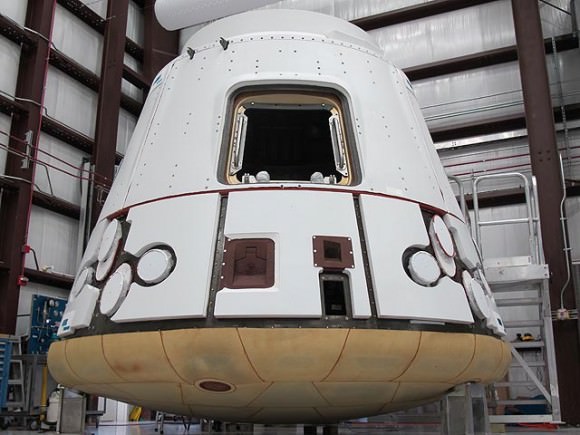
Falcon 9’s second flight will liftoff from Cape Canaveral Air Force Station and will closely match the first flight. However, on this mission the Dragon spacecraft will separate from the second stage of the rocket and test a number of crucial flight requirements. Some of these include, maneuvering, communications, navigation and reentry. The Dragon is designed to make touchdown on terra-firma but its initial landings will occur on water. These landings will be provided via its Draco thrusters – which may enable the craft to land within a few hundred yards of the desired target.
For its first demo flight, the Dragon will test out its systems as it conducts a number of orbits around the Earth. Afterward it will fire its thrusters and reenter the Earth’s atmosphere. The splashdown is planned to take place in the Pacific Ocean off the coast of Southern California. The entire mission is not expected to last more than four hours.
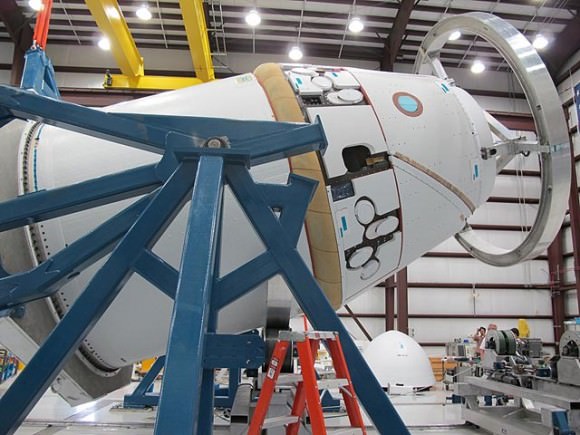
While the Dragon spacecraft does not have the space shuttle’s payload capabilities – it is designed to return payloads weighing up to 6,600 lbs. The shuttle is the only other craft that has such a large cargo return capability. The Russian Progress M1 spacecraft has a similar payload capacity but it is not currently designed to return to Earth (the Progress burns up in the atmosphere). This would be a huge leap forward for returning payloads (and hopefully, eventually people) from the ISS.
Under NASA’s new direction, it is hoped that by investing in commercial crew transports that competition will be created and thus lower the cost for access to space.
SpaceX recently conducted a successful wet dress rehearsal (WDR) that included rolling the rocket out to the launch pad, located at Cape Canaveral Air Force Station’s Launch Complex 40. It was then loaded with fuel and went through a complete launch sequence – right up until launch. It was then de-fueled and “safed.” The procedures of the wet test included specific procedures required for the inclusion of an operational Dragon spacecraft.
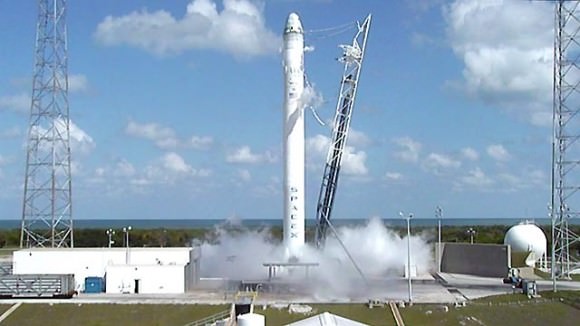
Before the WDR, SpaceX completed the first integration of its Falcon 9 and an operational Dragon spacecraft. The Dragon will be integrated onto the Falcon 9 rocket horizontally within the hangar. This helps to eliminate the cost of constructing and maintaining a vertical mobile service tower. It also makes processing of the payload less complicated. After integration is complete the Falcon 9 with the Dragon spacecraft will be moved to SpaceX’s mobile transporter/erector and be moved out of the hangar to the launch pad and then it will be erected vertically. The next step will be to conduct a static firing which is scheduled to take place in the coming weeks.
The Dragon is designed to be similar to the Russian Soyuz/Progress spacecraft in that they can be used to launch both materials and astronauts into orbit. The spacecraft includes eighteen Draco engines, hypergolic fuel systems, avionics, power systems, software, guidance, navigation, the largest PICA-based heat shield yet to fly, and a dual-redundant deployment system for the spacecraft’s three recovery parachutes.
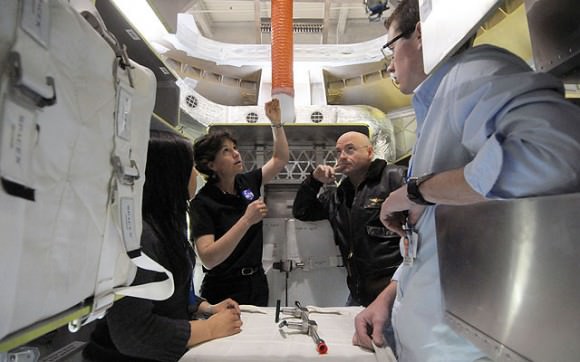
NASA astronauts have been trained in how to use the Dragon’s systems. Under both the COTS and Commercial Resupply Services (CRS) programs over a dozen astronauts from NASA, the European Space Agency (ESA) and the Japanese Aerospace Exploration Agency (JAXA) have been taught how to use the spacecraft’s controls. There has been a mutual exchange of information, as the astronauts learned about the spacecraft’s operating systems, SpaceX employees have been given insights about what it takes to live and work in space. This knowledge will eventually make its way into procedures and flight hardware.

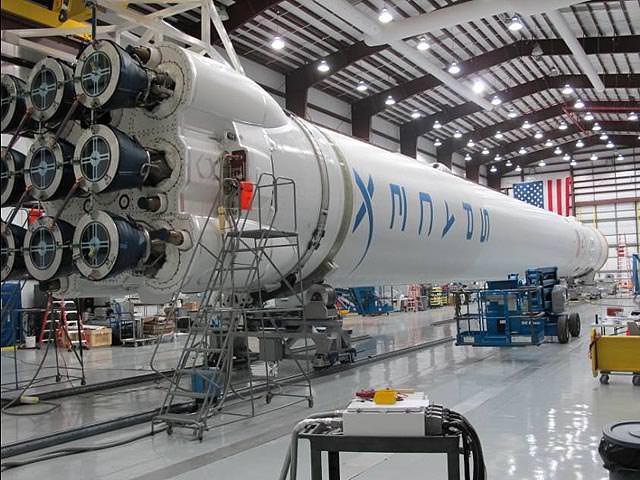
GO Space X!
9 main engines! WOW~ I wonder if they throttle the engines to enhance the shape of the exhaust during ascent?
Funny, when I hear about Merlin engines, I think about Spitfires & Hurricanes , not Dragons. Must be my age!
I actually find this rocket ugly in design.
I think that they should put a designer on it to make it look more sexy.
That’s an excellent point Tramman. Rolls Royce Merlins were so successful, they also found their way into the Avro Lancaster, Handley Page Halifax, Wellington Mk.II, Beaufighter Mk.II and de Havilland Mosquito. The idea being that concentrating on one great engine for multiple applications would cut the cost and time of war production.
In respect of the F9/Dragon, 32 engines might sound complex and expensive, but there are only two types. 9 Merlin main engines (~600 kN kerosene/LOX ) on the 1st stage, a 10th Merlin and 4 reaction control Dracos (0.4 kN hydrazine/tetroixde) thrusters on the 2nd stage and 18 Dracos on the capsule. Restricting a large number of engines to just two types keeps the design simple and drives down the costs.
The competition, the venerable Soyuz, also uses the many engines of a few types construction.
http://www.spaceflightnow.com/station/exp25/101005rollout/
There’s is a lot riding on this test flight so thanks for the update UT.
OLAF said:
I actually find this rocket ugly in design.
I think that they should put a designer on it to make it look more sexy.
I agree. The current design is just Spa-ceXy and looks like a giant white crayon.
The other COTS offering, Oribtal Science’s Tarus II, has a nearly identical shape.
http://en.wikipedia.org/wiki/Taurus_II
The appearance will change if a large payload requires a fairing, otherwise clean straight lines win the day.
TERRYG – When I wrote about Orion you labeled me a “lobbyist” – when I write about Dragon you give thanks? Hmmm.
Hello Mr Rhian,
It would have been rude not to offer a word of appreciation after requesting a story and getting a first rate follow-up, hence the thanks.
When the Orion/Orion-lite story was doing the website rounds,
e.g. http://www.spaceref.com/news/viewpr.rss.html?pid=31667 and eventually UT, there was little to differentiate the story from Lockheed-Martin’s prepared material where they give themselves a huge self-congratulatory pat on the back, while dodging the bigger and all important issue of end use. If the corporate narrative goes unchallenged, the degree of investigative journalism involved is unclear and story becomes indistinguishable from what a lobbyist would write, hence the comment. IIRC, UT policy is to close all comments hiding them from view after a few months, but it’s nice that you read them. Thanks.
The Falcon9/Dragon update is actually a much bigger story than Orion/Orion-Lite. Falcon9/Dragon is about (1) a complete launch vehicle and re-entry capsule, with (2) a test flight less than a month away and (3) being the leading strategy to remove reliance on the Russian space agency for access to the ISS. Thanks again. By comparison, the Orion/Orion-lite story, is about (1) an incomplete capsule, which is (2) currently three years away from the first test fight and (3) if cancelled, might not be missed since the only firm mission offered thus far is the dubious ISS US lifeboat role which could easily be taken up by the Boeing or SpaceX capsules without the bloated price tag. Other firm missions for Orion have yet to be announced.
Lastly, some thanks in advance. Assuming next month’s test flight is a successful, many readers here will look forward to UT’s original take on the matter. Cheers TerryG